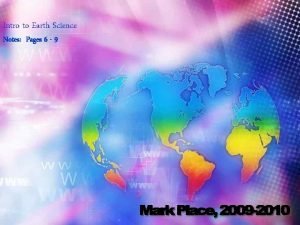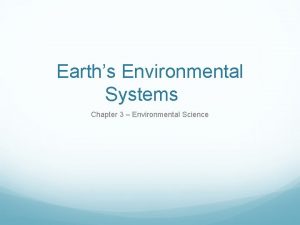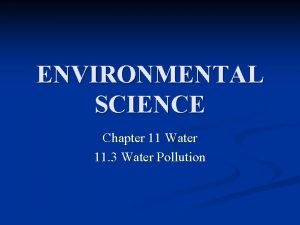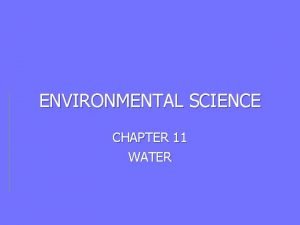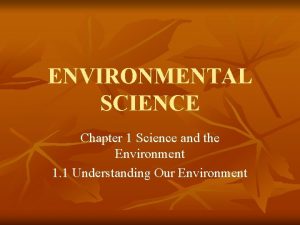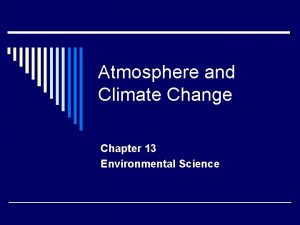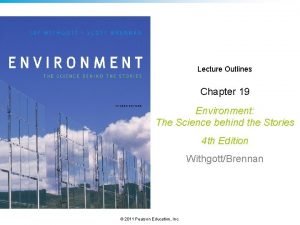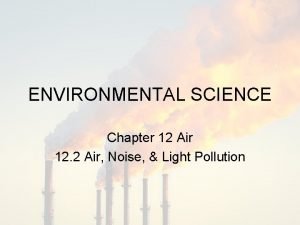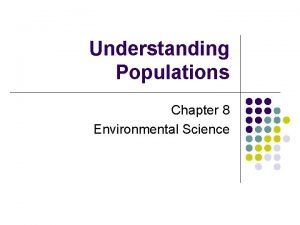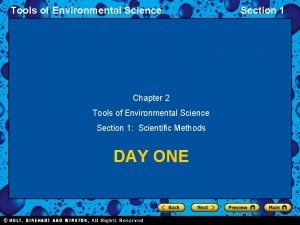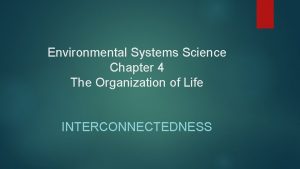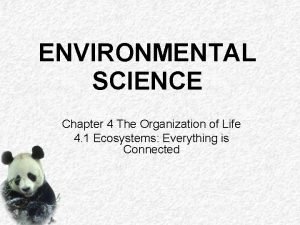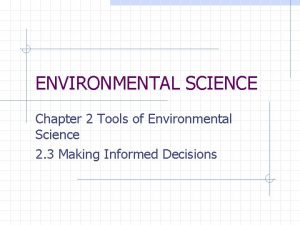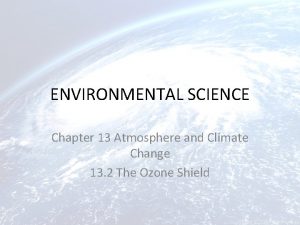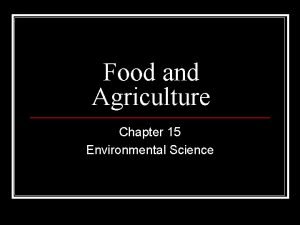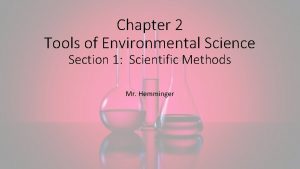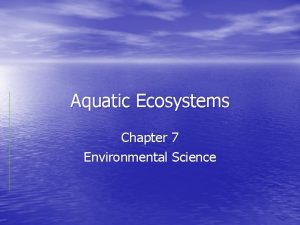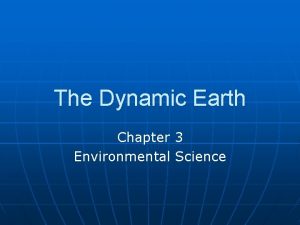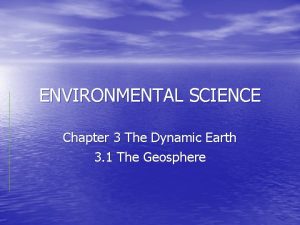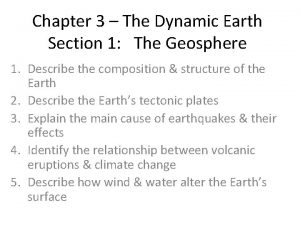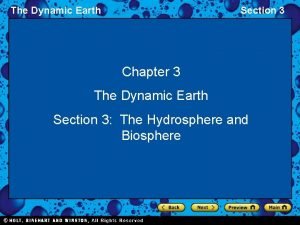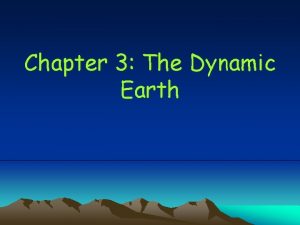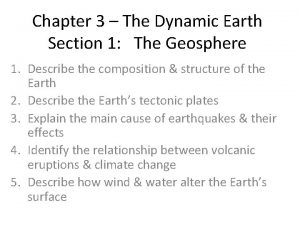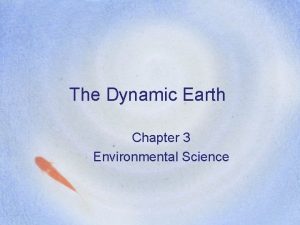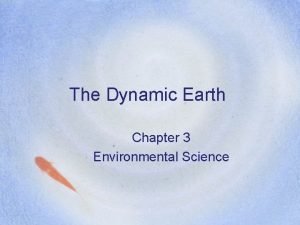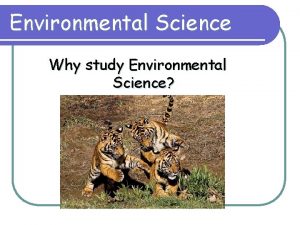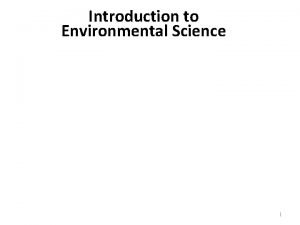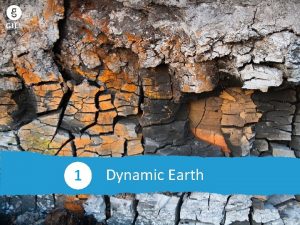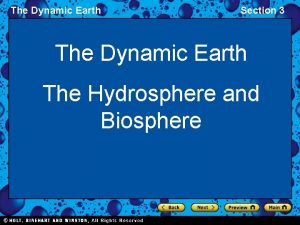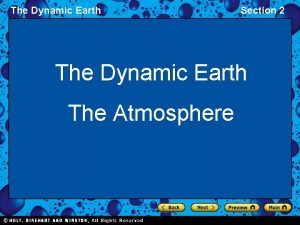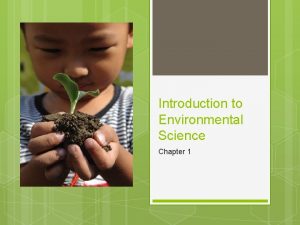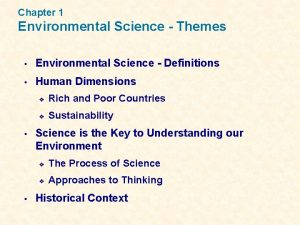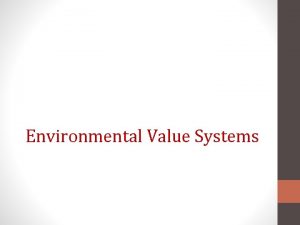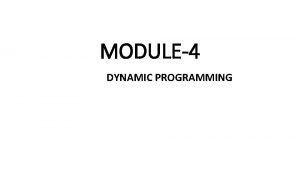The Dynamic Earth Chapter 3 Environmental Science Earth




























- Slides: 28

The Dynamic Earth Chapter 3 Environmental Science

Earth Integrated system n Rock • Geosphere n Air • Atmosphere n Water • Hydrosphere n Living things • Biosphere

Geosphere n n The solid part of the Earth including all rock, soils, sediments on the surface Scientists use seismic waves to study the geosphere. • Like tapping a melon

Composition of the Geosphere n Crust • Thin layer – less than 1% of Earth Oceans n Continents n n Mantle • Made of rock • 64% of the Earth n Core • Hot, dense rocks of nickel and iron • 35% of the Earth

Structure of the Geosphere n Five layers based on physical properties • Lithosphere n Includes crust and upper part of mantle • Asthenosphere n Rocks in the mantle that allow continents to move above it • Mesosphere n Lower layer of the mantle • Outer core n Dense, liquid layer • Inner core n Solid rock layer

Tectonic Plates • Pieces of the lithosphere that continents sit on • Glide on asthenosphere like ice on a pond • Figure 4 on page 62 • Plate boundaries are where activity occurs & mountain ridges form

Earthquakes n Occur at a fault • A break in the Earth’s crust where they slide against each other. n Richter Scale • Measures magnitude (0 -10) n The amount of energy released by an earthquake

Volcanoes n n A mountain built from magma that rises to the Earth’s surface The hot ash, dust and gases can pollute the environment A volcanic eruption can change the Earth’s climate for several years. Volcanic ash can mix with water • Mudflow

Section 1 Assignment n n Page 66 Section 1 Review #1 -5

Atmosphere n n Mixture of gases surrounding the Earth Gases are constantly being added and removed • Example – Animals release carbon dioxide and take in oxygen, plants release oxygen and take in carbon dioxide

Composition of the Atmosphere n Nitrogen • 78 % of the atmosphere n Oxygen • 21 % of the atmosphere n Other Gases • 1% of the atmosphere • Includes argon, carbon dioxide, methane, water vapor n Atmospheric dust • Particles in the air made mainly of soil n Also includes salt, ash, pollen, bacteria, aerosols

Layers of the Atmosphere n Troposphere • Closest layer to the Earth’s surface • Almost all weather occurs here n Stratosphere • Almost all ozone (made of 3 oxygen atoms) is located here • Ozone absorbs UV radiation

Layers of the Atmosphere n Mesosphere • Coldest layer n Thermosphere • Layer located furthest from Earth’s surface • Temperatures above 2000°C • Nitrogen and oxygen ions absorb X-rays and gamma rays

Energy in the Atmosphere n Energy transferred from the sun in three ways • Radiation n Transfer of energy from space to atmosphere • Conduction n Flow of heat from warmer object to colder object • Convection n Transfer of heat through air currents

Heating the Atmosphere n n n About half the energy from the sun reaches the Earth’s surface. The rest is absorbed by clouds, dust or gases. Dark-colored objects absorb more energy than light-colored objects.

Quick Lab n Page 70 n Answer the following questions: • By what mechanism is energy being transferred to the beakers? Explain your answer. • Make a line graph with the results of the experiment. • Page 72 – Section 2 Review #6 Answer with a paragraph

Greenhouse Effect 1. 2. 3. 4. Sunlight enters the atmosphere and heats the Earth’s surface The heat is radiated back into the atmosphere Heat is absorbed by gases in the atmosphere Heat is then radiated back towards the Earth’s surface. ** Earth would be too cold to survive without the greenhouse effect.

Greenhouse Gases n Gases that trap and radiate heat • Water Vapor • Carbon dioxide • Methane • Nitrous oxide

Quiz n Information from Section 1 & 2

Hydrosphere n n Any water on or near the Earth’s surface Water cycle • Evaporation • Condensation • Precipitation n Oceans • Pacific, Atlantic, Indian, Arctic

Ocean Water n Salinity • Concentration of all the salts in ocean water • Salinity varies depending on evaporation and precipitation n n Surface water is warm, deeper is cold due to no sunlight Oceans absorb heat from the sun which helps to regulate the temperature in the atmosphere.

Layers of the Ocean n The layers are called temperature zones. • Surface Zone n Warm water (heated from the sunlight) • Thermocline Temperature falls rapidly with depth n Cold water begins in this layer n • Deep Zone Bottom of the ocean n Temp around 2°C n

Ocean Currents n Surface currents • Streamlike movements at the surface • Created by the wind n Deep currents • Streamlike movements near the ocean floor • Flows very slowly towards the equator

Fresh Water n n Only about 3% of all water River system Main river n Tributaries n Land that drains into the river n n Groundwater • Collects underground • Used for human and agricultural needs • Aquifers n Rock layers underground that stores water

Biosphere n n Narrow layer on Earth’s surface that supports life Life on Earth exists due to two factors • Water is continually recycled • Sunlight is readily available n Includes the following: • Upper part of geosphere • Most of the hydrosphere • Lower part of atmosphere

Energy Flow n Closed system • Energy enters as sunlight • Matter does not enter n Plants use the sunlight to make their own food • Earth is considered mainly a closed system n Open system • Both energy and matter enter n Early years of the Earth when matter was added through collisions of comets and meteorites with our planet

Section 3 Review n n Page 81 # 1 -6

Chapter Review n n Page 83 -85 #6 -19, 21, 24 -25, 27, 32 -33, 34
 Why environmental science is an interdisciplinary science
Why environmental science is an interdisciplinary science Dynamic equilibrium earth science
Dynamic equilibrium earth science Earth's environmental systems chapter 3
Earth's environmental systems chapter 3 My favourite subject is music
My favourite subject is music Objective of water pollution
Objective of water pollution Is water that contains waste from homes or industry
Is water that contains waste from homes or industry Environmental science chapter
Environmental science chapter Environmental science chapter 13 review
Environmental science chapter 13 review Chapter 19 environmental science
Chapter 19 environmental science Environmental science chapter 2
Environmental science chapter 2 Chapter 12 air environmental science
Chapter 12 air environmental science Chapter 8 environmental science
Chapter 8 environmental science Chapter 2 environmental science
Chapter 2 environmental science The day they parachuted cats into borneo food web
The day they parachuted cats into borneo food web Chapter 4 the organization of life
Chapter 4 the organization of life Chapter 2 environmental science
Chapter 2 environmental science Chapter 10 biodiversity
Chapter 10 biodiversity Limestone ridges built by tiny animals
Limestone ridges built by tiny animals Chapter 13 environmental science
Chapter 13 environmental science Chapter 15 environmental science
Chapter 15 environmental science Chapter 2 tools of environmental science answer key
Chapter 2 tools of environmental science answer key Chapter 7 aquatic ecosystems
Chapter 7 aquatic ecosystems Chapter 3 the dynamic earth
Chapter 3 the dynamic earth Chapter 3 the dynamic earth
Chapter 3 the dynamic earth The dynamic earth chapter 3
The dynamic earth chapter 3 Chapter 3 the dynamic earth
Chapter 3 the dynamic earth Chapter 3 the dynamic earth section 1 the geosphere
Chapter 3 the dynamic earth section 1 the geosphere The dynamic earth chapter 3
The dynamic earth chapter 3 Wireless health
Wireless health

